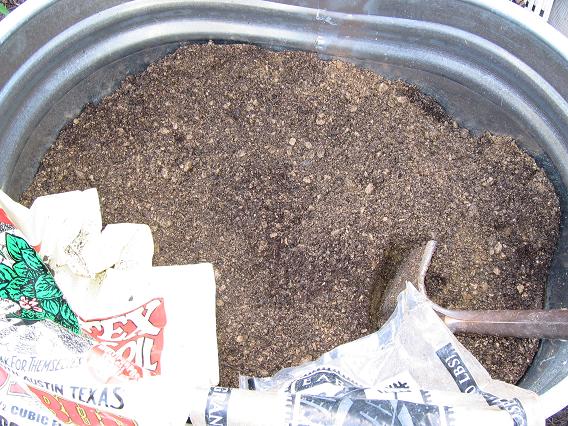
A standard formula for mixing planting medium is:
1 part soil
1 part peat moss
1 part perlite, vermiculite or sharp, clean sand
1 part compost (optional)
Find a container large enough to suit your needs and stir in the above ingredients until thoroughly mixed type of plant. The biggest mistake gardeners make with containers is shoveling garden soil into them. It compacts when used in containers. Compacted soil squeezes out oxygen, dries out easily, and is difficult to wet again thoroughly. All this results in unhealthy plants. Even though dirt from your yard is free, to use it alone in containers will cost you.
There are countless reliable growing mediums sold in garden centers, and they are a good investment. But, you can mix your own for less money than you can buy it.
You can incorporate garden soil in your mix to save some money. Use only a rich, loamy soil and sift out any clods, stones, sticks, or other foreign matter. Healthy transplants and established plants can tolerate raw soil in the mix. If you are starting seeds, however, pasteurize the soil you add to your mix: Garden soil teems with tiny life-forms, from visible bugs to invisible ones. This is a dirty, smelly job and a great argument for germination mixes without soil. To kill off all soilborne organisms properly, heat soil to over 140°F for about thirty minutes. You can do this with pans in an oven.
Customize mixes for the type of plants you are growing. For plants requiring free drainage, such as cacti or succulents, add an extra part of sand or perlite. For those with specific nutritional requirements, mix in fertilizer accordingly.
The container. As for the containers you should use, there are a few things to consider. Will you be raising food or ornamentals in them? Never grow food crops in containers that have previously contained something unknown or questionable. Plant roots transport many toxins; they could end up on your dinner table. Also, the container must have drainage holes at the bottom. A larger container requires more and larger holes. Poor drainage kills off more plants than anything else.
The material the container is made of can affect the plants. Metal containers get very hot in direct sun and transmit the heat to tender plant roots. Black plastic pots absorb more heat than light-colored ones. But many plants, such as poinsettias, must have their roots in a dark environment. Wood containers may harbor fungi. Stone or brick containers absorb heat, and release it slowly. Terra cotta or clay pots are decorative, but they absorb water away from plant roots. Peat pots also absorb water from roots.
Lovely, decorative containers abound in trendy garden centers, and they can set you back a few bucks if you must have them. But creativity and an eye for unusual items are free.
Salvage an old pair of cowboy boots, and fill them to overflowing with lobelia or ivy geraniums. An old wheelbarrow makes a purposeful planter, deep enough for carrots, large enough for broccoli, and decorative enough for a variety of flowers and trailing vines. Wooden crates, dented metal buckets, plastic-lined wicker baskets, hollowed-out logs, leaky watering cans, antique milk cans, discarded lunch boxes, junked, claw-footed bathtubs, unseaworthy rowboats or canoes, and countless other finds make fun, functional, frugal planters. See what you can find.

No comments:
Post a Comment